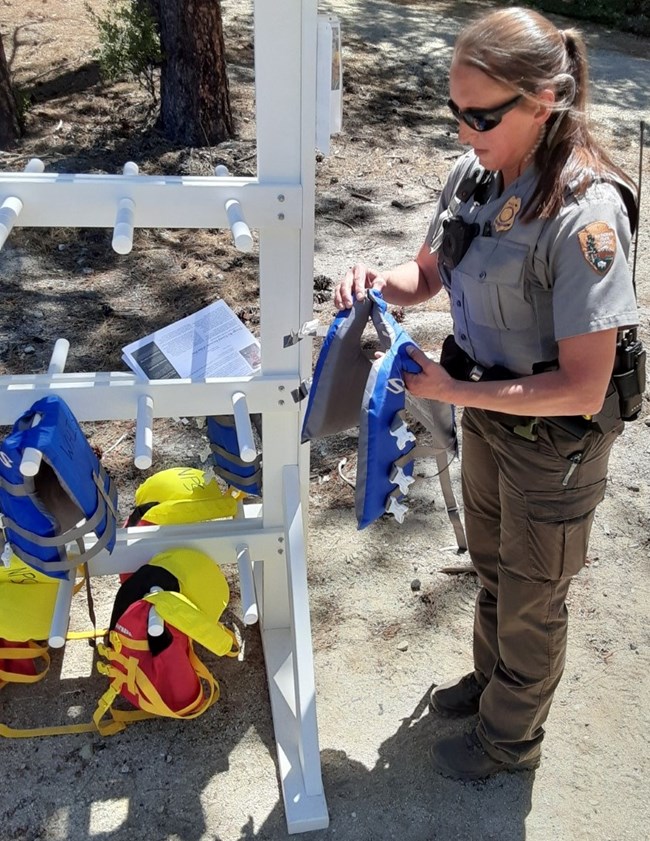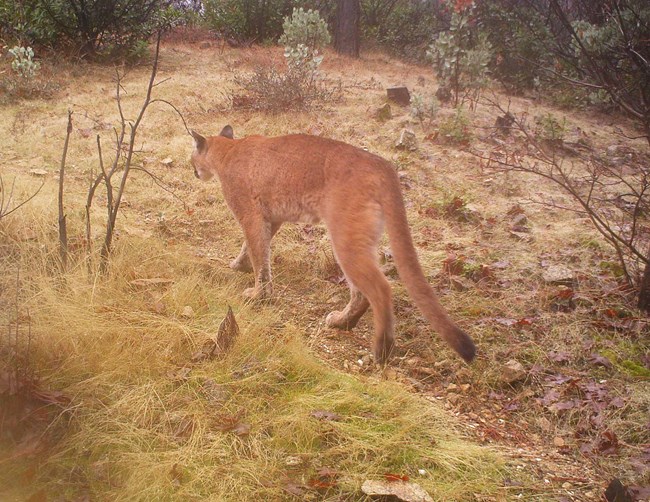
Be Safe and Respect the Law
For a positive and safe park experience, abide by these common rules and regulations. 
Plan Ahead for a Safe Day on the Water
Plan Like a Park Ranger for a safe and positive day on the reservoir by following these seven steps... Staying Safe at Whiskeytown: Rules, Regulations, and Natural HazardsOur goal is to ensure you have a safe and enjoyable experience at Whiskeytown National Recreation Area. Understanding and following the park’s rules and regulations will help protect you and others during your visit. In addition, being aware of the natural hazards present in the park—and knowing how to respond if they occur—can significantly enhance your safety. 
NPS photo. Lifejackets Save Lives: Stay Safe on the WaterDid you know that under California law, every child under the age of 13 must wear a Coast Guard-approved lifejacket aboard all moving vessels, including kayaks and paddleboards? For individuals 13 years and older, a Coast Guard-approved lifejacket must be kept onboard at all times. This rule is critical because many drownings happen each year due to the absence of lifejackets. At Whiskeytown Lake, we average about one drowning per year, and the common factor in all of these tragic incidents is that the individual was not wearing a lifejacket. Wearing a lifejacket is not just the law—it’s a lifesaving measure that can make all the difference. If you're under 13, always wear one on the water. If you're 13 or older, be sure to at least have one with you—it could save your life! Lifejackets Are Recommended at the BeachWe highly recommend lifejackets for youth, not just on boats, but also when playing near the water, swimming, or at the beach. To make it easier, we offer a Free Lifejacket Loaner Program for children weighing between 50 and 90 pounds at Oak Bottom Beach and Brandy Creek Beach from Memorial Day Weekend through Labor Day Weekend. The program is simple and convenient—just grab a lifejacket from the rack, and when you’re done, kindly return it so it’s available for the next visitor. It's an easy way to protect your loved ones and help others do the same! Burned Area SafetyVisitors are reminded that Whiskeytown National Recreation Area is a natural environment, and outdoor recreation always carries some risk. However, the Carr Fire has significantly heightened these risks in certain areas. Hazards such as falling trees, broken or hanging limbs, burned-out stump holes, abandoned mine features, and loose rocks are present in many sections of the burned area. Increased Risk During Winter StormsWinter storms amplify these dangers. The loss of trees and vegetation has accelerated erosion and runoff, leading to severe risks like flooding, landslides, and debris flows. The watersheds at the base of Shasta Bally—including Brandy Creek, Boulder Creek, Paige Boulder Creek, and Mill Creek—are of particular concern due to their high potential for debris flows. These fast-moving, water-laden masses of soil, vegetation, and rock can rush down mountainsides, gathering additional debris in their path and forming fan-shaped deposits in valleys. Smaller landslides and floods may occur anywhere in the park during rain events. For your safety, please do not enter any closed areas of the park. Check our Alerts & Current Conditions page before your visit. Stay Alert While HikingIf you’re hiking in open areas of the park, be mindful of your surroundings at all times. Pay attention to both the ground beneath you and the area above you for potential hazards like loose rocks or falling limbs. Your safety is our top priority. By staying aware, respecting closures, and watching for potential hazards, you can enjoy the beauty of Whiskeytown while keeping yourself and others safe. 
NPS photo. Rattlesnake CountryLike much of California, Whiskeytown is home to rattlesnakes. A rattlesnake bite injects venom, which can be dangerous to both pets and humans, especially children. To avoid the risk of a rattlesnake encounter:
If you are bitten by a rattlesnake, call 911 immediately. Stay as calm as possible and try to move as little as necessary. Remove any tight clothing or jewelry near the bite, as swelling will likely occur. Stay still and wait for help to arrive. By staying aware of your surroundings and taking precautions, you can safely enjoy your visit to rattlesnake country. 
NPS photo. Bear CountryWhiskeytown is home to a healthy population of black bears. Adult male black bears typically weigh under 400 pounds, while females weigh less than 250 pounds. Despite their bulky appearance, black bears can run up to 30 mph for short distances, climb trees, and swim. Although their eyesight isn't as sharp as a human's, black bears have excellent hearing and an extremely keen sense of smell. As omnivores, black bears spend most of their waking hours searching for food, eating both plants and animals. This constant search, combined with their sharp sense of smell, often brings them close to human activity, especially in camping areas. Problems arise when bears access human food or trash, leading them to become "conditioned" to being around people, which can make them aggressive and dangerous. By following these simple rules, you can help keep Whiskeytown’s bears wild and safe:
Report all bear sightingsHelp us protect both bears and people. Report all bear sightings to a park ranger or call park headquarters at (530) 242-3400. 
NPS photo. Mountain Lion CountryFew visitors ever encounter a mountain lion (also known as puma, panther, or wildcat) in the wild, but these elusive animals have occasionally been known to attack people and pets. When venturing into mountain lion territory, taking precautions can help you stay safe:
If you encounter a mountain lion, follow these behaviors to signal that you are not prey and that you may be dangerous to the lion:
Reprt All Mountain Lion SightingsPlease report all mountain lion sightings to a park ranger or call park headquarters at 530-242-3400. |
Last updated: November 21, 2024
